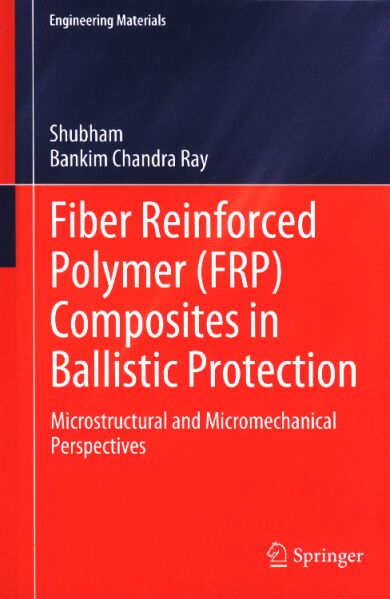书名:Fiber reinforced polymer (FRP) composites in ballistic protection
责任者:Shubham | Bankim Chandra Ray
出版时间:2024
出版社:Springer Nature Singapore Pte Ltd.
分类号:一般工业技术
页数:xviii, 141 p.
摘要
This book highlights the pulchritudinous features of FRP composites emphasizing failure criteria referring to microstructural as well as micromechanical aspects. The potential and promises of this class of material as being explored for supercritical applications necessitate the analysis and assessment of FRPs with a spectrum of low to high strain rates. Additionally, constitutive modeling and shock properties of polymeric composites along with the data processing techniques and relevant theories for different characterization methods are conversed. The findings of previous studies available on mechanical characteristics of polymer composites under quasi-static and high-strain-rate circumstances are also discussed. The dearth of open literature and limited information culminate the need for this book which may eventually bridge the existing gap.
查看更多
目录
封面 1
目录 14
1 Introduction to Composite Materials 18
1.1 Composite Materials: Definition and Development 18
1.2 Classification of Composite Materials 20
1.3 Some Commonly Used Fiber-Rein forced Polymer Composites 22
1.3.1 Glass Fiber-Reinforced Polymer (GFRP) Composites 22
1.3.2 Carbon Fiber-Reinforced Polymer (CFRP) Composites 23
1.3.3 Aramid Fiber-Reinforced Polymer Composites 24
1.3.4 Other Fiber Reinforcement Materials 26
1.4 Major Application of Fiber-Reinforced Polymer Composites 27
1.4.1 Aerospace and Outer Space 27
1.4.2 Structure Repairing (Underwater) 29
1.4.3 Boats and Marine 30
1.4.4 Automobile and Railways 31
1.4.5 Building and Infrastructure 34
1.4.6 Defenses: Air, Water, and Land Megastructures 35
References 36
2 Polymer Matrix Materials for Ballistic Armors 38
2.1 Definition and Characteristics of Polymer Matrix Materials 38
2.2 Advantages and Disadvantages of Using Polymers in Ballistic Armor 40
2.2.1 Advantages 40
2.2.2 Disadvantages 40
2.3 Types of Polymer Matrix Materials 41
2.4 Overview of Common Polymers Used in Ballistic Armor Applications 42
2.5 Comparison of Different Polymer Types and Their Suitability for Specific Armor Requirements 42
2.6 Polymer Processing Methods 45
2.6.1 Extrusion 45
2.6.2 Compression Molding 45
2.6.3 Other Shaping Techniques 46
2.7 Armor Design and Manufacturing 46
2.8 Performance Evaluation 47
2.8.1 Overview of Industry Standards 48
2.8.2 Material Performance Criteria 48
2.8.3 Consistency in Testing 48
2.8.4 Quality Assurance and Certification 48
2.8.5 Ongoing Research and Development 49
2.9 Future Trends and Challenges 49
References 51
3 Fiber Reinforcements 52
3.1 Definition and Characteristics of Fiber Reinforcements 52
3.2 Types of Fiber Reinforcements 53
3.3 Some Popular Commercially Used Reinforcements 56
3.3.1 Glass Fibers 56
3.3.2 Carbon Fibers 58
3.3.3 Aramid Fibers 59
3.4 Natural Fibers 62
3.5 Comparison of Commercially Used Fibers 64
References 65
4 Characterization Techniques in Different Strain-Rate Spectra 68
4.1 Strain-Rate Spectrum Overview 68
4.2 Quasi-Static Rate Testing 69
4.3 Intermediate Strain-Rate Testing 70
4.4 High-Strain-Rate Testing 71
4.5 Impact Tests 73
4.5.1 Taylor Test Dynamic Characterization 73
4.5.2 Plate Impact Test 74
4.6 Challenges and Future Scope for Research 76
4.6.1 Challenges 76
4.6.2 Scope of Novel Research Approach 76
References 77
5 Microstructural Failure Mechanisms Analysis 80
5.1 Introduction 80
5.2 Key Determinants of Composite Material Impact Response 82
5.3 Damage Analysis 84
5.3.1 Low-Velocity Impact Damage Analysis 84
5.3.2 High-Velocity Damage Analysis 84
5.4 Fractographic Analysis 87
References 93
6 Micromechanics of FRP Composites and the Analytical Approach for Ballistic Response 96
6.1 Introduction 96
6.2 Fundamental of Micromechanics 97
6.2.1 Fiber-Matrix Load Transfer 97
6.2.2 Unidirectional Reinforcement 98
6.2.3 Discontinuous Fibers 101
6.3 Damage Mechanism Due to Ballistic Impact on Composite Structures 105
6.3.1 Cone Formation on the Back Face of the Target 106
6.3.2 Energy Absorbed Due to Deformation of Secondary Yarns 108
6.3.3 Energy Absorbed Due to Tensile Failure of Primary Yarns 109
6.3.4 Energy Absorbed Due to Shear Plugging 109
6.3.5 Energy Absorbed by Other Mechanisms 110
6.4 Analytical Formulation for Woven Fabric Composites 110
References 111
7 Recent Development of Constitutive Models for Strain-Rate Sensitive FRP Composite Materials 114
7.1 Need for Constitutive Modeling in FRP Composites 114
7.2 Some Important Developments Till Now 115
7.3 Constitutive Law 118
7.4 Temperature-Dependent FRP Behavior 119
7.5 Strain-Rate Dependent FRP Behavior 120
7.6 Concluding Remarks 121
References 122
8 High-Velocity Impact Modeling in Materials Science: A Multiscale Perspective 126
8.1 Introduction 126
8.2 The Role of Multiscale Modeling 126
8.3 Multiscale Modeling Techniques 127
8.3.1 Ab Initio (First-Principles) Modeling (Quantum/Molecular Scale) 128
8.3.2 Molecular Dynamics (MD) Simulations (Atomic/Molecular Scale) 132
8.3.3 Discrete Element Method (DEM) (Paniculate Scale) 136
8.3.4 Mesoscale Modeling (Mesoscale) 136
8.3.5 Smoothed Particle Hydrodynamics (SPH) (Mesoscale) 138
8.3.6 Finite Element Analysis (FEA) (Macroscopic Scale) 139
8.4 Micromechanical Modeling for Impact 141
References 142
9 Interface Engineering 144
9.1 Introduction 144
9.2 Interface Engineering of Ductile Fiber/Thermoset Matrix Composites 145
9.3 Fiber Surface Treatments 147
9.3.1 Glass Fibers 148
9.3.2 Carbon Fibers 149
9.3.3 Kevlar Fibers 151
9.4 Influence of Strain Rate on the Sandwiched Epoxy Interface Properties 151
9.4.1 Sample Preparation 152
9.4.2 Quasi-Static Indentation 152
9.4.3 Dynamic Indentation 154
9.4.4 Nanomechanical Raman Spectrometry 155
References 157
封底 159
查看PDF
查看更多
馆藏单位
中国科学技术信息研究所



